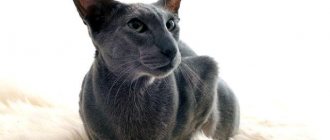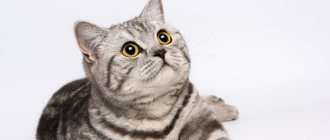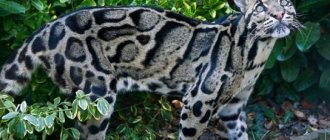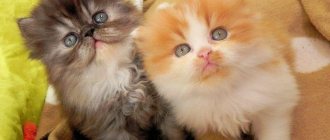Beautiful, proud and dexterous, like a leopard, affectionate, playful, like a beloved pet. This is all about the leopard cat, which is also known by other names: Bengal or Asian. Representatives of this breed are naturally curious and willful, but this is only a small part of what future owners need to know about these cats.
Keeping leopard cats in captivity
Asian leopard cats are kept both indoors and outdoors in an enclosure. When kept outdoors, set up a cage measuring 1.5 x 3 x 1.5 m. The mesh size should be no more than 50 x 50 mm. The floor is preferably wooden. Sometimes they arrange areas with a mound of earth in which various herbal plants are planted. This is done to enrich the cat’s habitat and for the aesthetic component. To maintain cleanliness, it is most convenient to organize a restroom, which is a large tray. Be sure to install a shelter for the cat. This is a small wooden booth with a straw bedding inside. As for temperature, different types of Bengal cats tolerate frost differently. For southern subspecies, the booth should be heated, the optimal temperature is +20°C. The northern ones bring cold weather more calmly. Tree cuts and shelves are installed in the enclosure at different heights.
Upon reaching puberty, even domesticated animals become aggressive and uncontrollable. Especially in the absence of the opportunity to fulfill sexual instincts. Further castration or sterilization helps solve this problem. If dilution of ALC is not planned, surgery is indicated before puberty.
Maintaining an active lifestyle is very important for physical and social development, as well as reproductive health. These can be various games, toys, artificial mice
From time to time, several bunches of black grass or wheatgrass are picked up on the floor of the cat’s enclosure. The smell of freshly picked grass will diversify your pastime and make you activate your olfactory center. Another useful activity would be catching live food.
Walking kittens and adult cats is very important for full psycho-emotional and physical development. The domestic Asian leopard cat needs regular walks in the fresh air, where it receives ultraviolet light, feeds on meadow grass, and gets acquainted with new smells.
Ocelot
This predatory cat (field tiger, Leopardus pardalis) lives in the tropics of America and is similar to a leopard. He has a large head, strong paws, and well-developed muscles. The ocelot grows up to 0.5 m in height and up to 1.5 m in length, and weighs about 15 kg. The fur is very thick and short, light brown with black spots, white on the belly and neck, black ears, each cat has an individual pattern. Their population is endangered.
You should avoid breeding ocelots at home for the following reasons:
- The ocelot has a secretive nature and will not need your company.
- An ocelot will need about 0.5 kg of raw meat per day.
- For better taming, you should take a kitten that is still blind and feed it using a pacifier.
- For maintenance you will need a very high enclosure with an area of at least 15 m2 with a pool and trees.
- The ocelot marks its territory and does not allow anyone into it.
- He doesn't get along with other animals.
- Capable of harassing you with mating cries.
- The hunting instinct is well developed.
- A very proud cat.
- The cost of an ocelot is about 4 thousand US dollars.
History of the discovery of the golden Asian cat
Temminka received its name thanks to the efforts of the Dutch zoologist and naturalist Conrad Jacob Temminck, who was the first to describe it in 1827. Strictly speaking, the scientist had in mind a completely different animal and described the African golden cat, which is not even a relative of the Asian one. But the anatomy, appearance and living conditions turned out to be very similar. Such an evolutionary process, leading to the similarity of different systematic groups of animals, is called convergent evolution.
The Asian golden cat was first described in 1827
Temminck cat - Catopuma (Felis) temminckii, fire cat or, as it is also called, Asian golden cat belongs to the genus Catopum (subfamily of small cats) and is the closest relative of the Barneo (Kalemantan) cat.
Burmilla
Burmilla breed history: In 1981, the British breeder of Russian Blue cats Miranada Bickford-Smith (von Krichberg) bought a Persian chinchilla named Jemari Sunquist for her husband. He was supposed to be castrated, but the cat turned out to be more efficient than his owners, and therefore, before the operation, he managed to start an affair with Miranda’s European Burmese - Bambino Lilac Faberge. As a result, four charming cats of Burmese type and chinchilla color were born. These were the first Burmilla (Burmese + chinchilla). Miranda really liked the cats, and she and her friend Teresa Clark (Cartouche) began to develop a new breed. At the same time, Teresa focused exclusively on black chinchilla-colored Burmillas, and Miranda continued to experiment and had a hand in the formation of almost all Asian breeds. She even founded the Burmilla and Asian Cat Association in 1985, which is now called the Asian Group Cat Society AGCS.
Breed nutrition
If everything is fine with the kittens, then they grow quickly and by 3-4 months they already begin to hunt on their own. They hunt in the zoo, of course, on mice and lemmings thrown into their cages by zookeepers, but they also like lean beef.
The concentrated food from bags and cans familiar to our cats is strictly prohibited! And this is also another problem when raising young Pallas’ cats.
And, of course, the problem is their behavior! Pallas' cat kittens, by the age of hunting, grow very long, awl-shaped teeth, which with age will be replaced, of course, by wider and not so long permanent teeth, but the character inherent in nature is preserved from the first days.
These babies bite very painfully, inflicting painful wounds on the hand that feeds them, as soon as the attendant “gazes” a little while feeding or tries to stroke the pussy.
Behavioral characteristics and habitat
Steppe cats are crepuscular animals. They usually go hunting in the evening. It feeds on small rodents, birds and their eggs, lizards, insects and amphibians. Hunts from ambush, tracking prey and attacking in one leap. Before hunting, it licks itself thoroughly, hiding its scent. As a rule, these cats spend the day hiding in the burrows of porcupines or foxes or hiding in dense bushes.
They have enough enemies in nature: people, hyenas, jackals, dogs, large cats. When meeting an enemy, the steppe cat, if it does not have time to escape, arches its back, turns sideways to the danger, bristles its fur, presses its ears back and hisses, trying to appear larger and more terrible. When attacked, she falls on her back, fights off with her claws and howls furiously.
Steppe cats fight back furiously when attacked
Most of the time, these cats are silent and do not make unnecessary sounds. The range of their “speech” is quite large: snorting, hissing, grumbling, meowing, howling. They become most vocal during the rutting period.
Steppe cats live alone, meeting only during the mating season. However, at the same time, they have rich facial expressions and a wide variety of poses through which they communicate with their relatives.
A female steppe cat most often gives birth to three kittens.
The mating season for steppe cats usually begins at the end of January and lasts until the beginning of March. At this time, the males are unusually active, chasing each other with loud meows and fighting for the female.
Pregnancy lasts 2 months. From 2 to 6 cubs are born, which the female raises alone. Kittens are born blind and deaf, and gain sight and hearing by 9–12 days of age. The female feeds them with milk for up to 2 months, then switches them to meat food. From 3 months, cubs go hunting with their mother. The cubs go “free swimming” at the age of 6–9 months, when the change of teeth from milk to molars ends.
Steppe cats become independent at 6–9 months
Steppe cats become sexually mature by the age of one year, but do not participate in reproduction until the age of 2 years. In captivity they often live up to 8–10 years; in the wild they live much shorter. They settle, as a rule, next to colonies of rodents, and often next to human settlements.
Where can you find the steppe cat:
- In the steppe, desert and sometimes mountainous regions of Africa.
- In Western, Middle and Central Asia.
- In Northern India.
- In Transcaucasia.
- In Kazakhstan.
- The steppe cat is also found on the territory of Russia, in semi-desert areas or floodplain bushes of the Astrakhan region, where it usually stays close to water.
Prairie cats are territorial. The hunting grounds of one animal can range from 2 to 5 km2. Females tend to have a smaller territory.
The habitat of the steppe cat - Africa and Central and South Asia - is declining very quickly
Range – where does the snow leopard live?
Habitat of the snow leopard
Since each individual has its own territory from 15 to 200 km, into which other brethren are prohibited from entering, even with a small number, their habitat is quite large.
Snow leopards choose steep mountains as their place of residence, preferring to settle at an altitude of 1500 to 6000 meters above sea level. Depending on the surrounding conditions, the animal can descend into forest areas in search of food or climb to the very tops of rocks.
Now snow leopards are found mainly in Mongolia, Kazakhstan, Afghanistan, Russia, India, China, Tajikistan and Uzbekistan. They can be found in mountainous areas with little snow cover and extensive bushes.
Interesting fact: only 2% of the total number of snow leopards live in Russia.
Taming the Far Eastern forest cat
Since Amur cats are only slightly larger than the usual domestic cat and look about the same, many exotic lovers have an irresistible desire to own such a fluffy cat. The only difficulty is that the blood of wild predators flows in the veins of this mustache. And the call of the ancestors can wake up at any moment.
Amur cats are almost impossible to train
Far Eastern forest cats are independent and willful
Not a single attempt to tame or train these furry predators has been successful. Moreover, such undertakings often ended in injury to the “trainers.” After all, if it is impossible to escape from people, the Amur cat instantly turns into an aggressor. And as you know, the fearlessness of an angry mustachioed cat knows no bounds.
A friend works as a huntsman in the Far East, he once picked up such a kitten (the cat died, most of the kittens too, this one survived) very small, still a milky one, he was completely exhausted, almost dead, well, he came out, fed him, he grew up and went to live in the forest has not taken root in the house, but it comes to visit regularly, it will come, eat it for free and leave, it will not be allowed into the hands of anyone, not even Yegor (the huntsman).
When purchasing a Far Eastern forest cat to live at home, you need to remember the following:
- such a kitty does not go “in your arms”;
- wild murka does not eat “from the palm of your hand”;
- the spotted cat will sleep during the day and wander around its assigned territory at night (if not retrained);
- During the mating period, aggression will intensify, which is why the animal can fill the house with heart-rending screams.
It is also important that even individuals taken at three months of age become wild as they grow and strive to return to their natural environment by any means.
Conditions of detention
Since this animal is listed in the Red Book, the official sale of Amur forest cats into private hands is prohibited. However, there are cases when animals still end up in the same home with a person - given by a zoo or picked up by a familiar hunter. Cases of smuggling are also not excluded. And then the owners need to decide on the living conditions of the wild predator in the house or even apartment.
It is advisable to keep Far Eastern forest cats in closed enclosures
Experts unanimously recommend limiting the living area of the Far Eastern forest cat to a spacious enclosure. It should have devices for climbing and jumping (beams, tree trunks and cuts, shelves), as well as a convenient “nest”. This can be made in the form of a house like a doghouse. In addition, you need to take care of the pet’s tray by filling the “toilet” with sawdust or sand.
Best articles: Political map and list of all African countries with names of capitals
Important nuance! According to Russian legislation, keeping Red Book animals in captivity, including Amur forest cats, is punishable by a fine of up to 1 million rubles. or forced labor for up to 3 years.
Lives great at home!!!!! Yes, he doesn’t often sit on his lap and purr, but ROARLS! But he feels great in the apartment and eats his mice and birds and meat. We got here by accident - the zoo didn’t accept us!!!! It was a pity to give it away to someone unknown! Stayed and feel great in a Moscow apartment! Doesn't tear up wallpaper, doesn't shit anywhere! It marks, but this issue has also been resolved - we put protective glass in the places where it marks - we remove it and there are no problems!
In the wild, Far Eastern cats cannot always afford to consume food every day. This is worth remembering when dealing with an animal that has come to a person as a pet.
Wild catfish from the banks of the Amur should be fed once a day, preferably at the same time. The diet should include poultry, lean beef, veal and rabbit
To maintain dental health, it is important to feed the animal mice and uncut bird carcasses.
In addition, once a week you can pamper your pet with the following food:
- raw chicken or quail eggs;
- sea fish (both fresh and boiled);
- boiled vegetables (pumpkin, carrots, zucchini).
But you shouldn’t give porridge to your pet - they can cause fermentation in the intestines and disrupt the functioning of the digestive system. You should also exclude milk, bakery products, alcohol, spices, fried and salty foods from the menu.
Animals must have access to clean drinking water.
Amur forest cats are difficult and brave animals native to the Far East. These animals have been cherished for a long time, and for lovers of exotic fluffy beauties they become a desirable trophy in the home nursery. However, we should not forget about the negative aspects of keeping a Far Eastern cat at home - the aggressive behavior of the purr and criminal liability for owning a Red Book animal.
I write articles on various topics
Population status
Currently, the Amur forest cat is included in the Red Book. The exact number of cats of this subspecies is unknown today. According to rough estimates, it does not exceed two and a half to three thousand individuals.
According to the generally accepted point of view, the number of Amur cats has decreased by at least a third. Part of the responsibility for the sharp decline in wild cats lies with humans themselves, as they are involved in:
- plowing virgin soil;
- cutting down bushes;
- setting fire to stakes (small forests in the fields).
Many representatives of the subspecies fell into hunting traps and snares, originally intended for hares. Uncontrolled natural fires also played a destructive role.
All the negative factors described above led to the fact that in 2015 there were only a few thousand Amur forest cats.
Prevention of extermination
Thanks to the efforts of animal rights activists, a significant fine was introduced for the destruction of Amur cats, reaching several thousand rubles. In the near future, it is planned to systematically inform local residents, especially hunters, about rare representatives of the local fauna, as well as about the usefulness of wild cats in the fight against rodents. Also, Far Eastern cats are under vigilant supervision in Japan, where about fifty representatives of the subspecies live.
Reserves
It is difficult to overestimate the contribution of protected areas in the regions, which provide greater safety for animals. The list of such territories includes
- Land of the Leopard National Park;
- Kedrovaya Pad Nature Reserve;
- Bolshekhehtsirsky Nature Reserve;
- Lazovsky Reserve;
- Khanka Nature Reserve;
- Ussuri Nature Reserve.
Zoos
The Far Eastern leopard cat is a rare guest in zoos. It is mainly kept in zoos in China and Japan, but in Russia there are several places where this animal lives, for example, the Barnaul Zoo.
They say that Amur cats do not live in zoos, but simply die for a long time
There are several reasons for such a low prevalence of the Amur cat. Firstly, catching a wild cat specifically for collection is not an easy task. That is why the Amur cat was and remains one of the most poorly studied subspecies.
Secondly, leopard cats languish in captivity. Even in a zoo, where no one and nothing threatens the cat, the wild animal remains wild and extremely cautious. As a rule, he builds a hole for himself or uses an already prepared one, only occasionally coming into contact with people and other inhabitants.
When surrounded by people and other animals, cats remain withdrawn and cautious.
Despite the unadaptability of wild cats to life in a cage, in zoos and enclosures the life expectancy of representatives of the subspecies is 17-18 years, while in the wild they are given 10-12 years. However, there are a variety of assumptions about the number of years allotted to a forest cat by nature. Some argue that 18 years is not the limit.
Parasitic bees
Among bees there are entire subfamilies of kleptoparasites - insects that appropriate other people's nests and food. In other words, they live off the labor of other bees. They are called cuckoo bees due to their similar behavior to birds of the same name.
Neon cuckoo bee
In such species, the body is not sufficiently developed to collect pollen and nectar. They also do not build nests. Instead, insects throw their eggs into other people's homes. When a kleptoparasite larva appears, it can destroy other larvae and all food. Sometimes such bees destroy the queen of the colony, and themselves settle in the nest.
Behavioral characteristics and habitat
Steppe cats are crepuscular animals. They usually go hunting in the evening. It feeds on small rodents, birds and their eggs, lizards, insects and amphibians. Hunts from ambush, tracking prey and attacking in one leap. Before hunting, it licks itself thoroughly, hiding its scent. As a rule, these cats spend the day hiding in the burrows of porcupines or foxes or hiding in dense bushes.
They have enough enemies in nature: people, hyenas, jackals, dogs, large cats. When meeting an enemy, the steppe cat, if it does not have time to escape, arches its back, turns sideways to the danger, bristles its fur, presses its ears back and hisses, trying to appear larger and more terrible. When attacked, she falls on her back, fights off with her claws and howls furiously.
Steppe cats fight back furiously when attacked
Most of the time, these cats are silent and do not make unnecessary sounds. The range of their “speech” is quite large: snorting, hissing, grumbling, meowing, howling. They become most vocal during the rutting period.
Steppe cats live alone, meeting only during the mating season. However, at the same time, they have rich facial expressions and a wide variety of poses through which they communicate with their relatives.
A female steppe cat most often gives birth to three kittens.
The mating season for steppe cats usually begins at the end of January and lasts until the beginning of March. At this time, the males are unusually active, chasing each other with loud meows and fighting for the female.
Pregnancy lasts 2 months. From 2 to 6 cubs are born, which the female raises alone. Kittens are born blind and deaf, and gain sight and hearing by 9–12 days of age. The female feeds them with milk for up to 2 months, then switches them to meat food. From 3 months, cubs go hunting with their mother. The cubs go “free swimming” at the age of 6–9 months, when the change of teeth from milk to molars ends.
Steppe cats become independent at 6–9 months
Steppe cats become sexually mature by the age of one year, but do not participate in reproduction until the age of 2 years. In captivity they often live up to 8–10 years; in the wild they live much shorter. They settle, as a rule, next to colonies of rodents, and often next to human settlements.
Where can you find the steppe cat:
- In the steppe, desert and sometimes mountainous regions of Africa.
- In Western, Middle and Central Asia.
- In Northern India.
- In Transcaucasia.
- In Kazakhstan.
- The steppe cat is also found on the territory of Russia, in semi-desert areas or floodplain bushes of the Astrakhan region, where it usually stays close to water.
Prairie cats are territorial. The hunting grounds of one animal can range from 2 to 5 km2. Females tend to have a smaller territory.
The habitat of the steppe cat - Africa and Central and South Asia - is declining very quickly
Lifestyle
Their habitats are:
- tropical or pine forests;
- semi-deserts;
- area near rivers;
- territories located at an altitude of 3000 m above the ground.
Wild Asians build their homes in:
- tree hollows;
- caves;
- dens.
In their natural homes, Asian cats mostly sleep during the day, as they are nocturnal, hunting for other animals, because they are predators. To do this, they easily climb to the tops of trees, hoping to find food there, which for them is:
- small birds;
- proteins;
- tree shrews.
INTERESTING TO KNOW: Why are there so many cats in Cyprus?
These cats often live near bodies of water, so their diet may include various members of the amphibian family. They feed on insects, mammals, and lizards.
If desired and necessary, they can swim in rivers, climb mountains, even climb rocks. These predators are usually solitary. They are rarely seen near human habitation. They prefer to spend time in pairs only during the mating season, after which 2 or 3 kittens are born.
A pair of cats that have offspring usually raise children together for 8 months. Evidence that kittens are predators is the presence of fangs within a month after birth. By this age they are ready to taste solid food.
Forest cat nutrition
The nuances of the forest mustachioed diet depend on its species. The Red Book contains information about some populations. Forest cats mentioned in it should not be captured. However, exotic lovers sometimes circumvent the law. It is better not to ignore the usual diet of forest animals. So:
- The Caucasian cat loves fish, eggs and chicks, and lizards. Representatives of the species hunt on the ground. At home, it is advisable to place the bowl on the floor.
- Representatives of the Amur species prefer rodents and birds. In second place in terms of taste preferences: squirrels, frogs, minks, chipmunks, freshwater fish. Living in Siberian conditions, the Amur cat often goes hungry in winter. You have to go to people, carrying their chickens and rabbits. If they are on the farm, having a forest mustachioed one is not the best idea.
- The African golden cat feeds on small monkeys and antelopes, tree hyraxes, and red duikers. In general, the diet is exotic, just like a cat. In Russian conditions, the mustachioed are served lean meats and fish.
- The forest cat from Norway is not averse to eating carrion. The diet of representatives of the species is extensive. If caught, they eat rodents, birds, eggs, lizards, fish, insects and worms. The Norwegians also need grass. Greens cleanse the intestines, removing hair. In the northern species, it is long and soft, actively molts and enters the digestive tract.
- The Asian leopard cat needs live food. The pet must kill the mouse and chicken himself. Prepared foods should make up no more than 80% of food consumed. You need to be careful with too much fish. Its abundance in the diet leads to the leaching of leopard mustache calcium from the body.
In many ways, the pet’s nutrition depends on the list of small inhabitants of the area where the mustache comes from. Partially, the price of a wildcat depends on this. For representatives of Russian fauna they ask for a minimum of 20,000, and for foreign guests - 35,000.
Nutrition and lifestyle
In many countries, the Pampas cat is called the “grass cat.” The animal prefers to be nocturnal, resting during the day in a safe shelter. The animals have excellent hearing and vision, as well as a phenomenal sense of smell, which allows them to track down prey. Predators prefer to eat chinchillas, mice, birds and their eggs, guinea pigs, lizards and large insects.
Despite the fact that a cat can easily climb a tree, the animal prefers food obtained on the ground. Adults can sit in ambush for a long time and attack the prey with one jump. Grass cats like to live alone in their marked territory.
If the Pampas cat is in danger, it immediately looks for a tree that it can climb. The animal's fur stands on end and the animal begins to hiss.
Nutrition
In terms of food, the forest cat is also a gourmet and a glutton: he prefers to eat fresh prey; his daily diet can consist of a dozen small rodents. An adult can consume up to a kilogram of food daily.
Top Articles: Natural Resources of North America
The victims of cats are:
- field mice
- Sony
- partridges
- pheasants
- coots
- gray rats
- muskrats
- trout
- nutria
- rabbits
- moles
- squirrels
- shrews
- caresses
- martens
- lizards
Once upon a time, cats living in the steppe regions caught bustards and even eagles; sometimes a large individual can defeat a small roe deer. Predators living on the banks of rivers and the inhabitants of floodplains hunt for fish and aquatic animals.
When approaching human habitation, cats free the surrounding area from the rodents that have settled there. While helping people in this way, they are doing harm at the same time by eating poultry. They cause harm to wildlife by destroying rare birds in protected areas (for example, in the Caucasus).
The meal process resembles that of an ordinary cat, but the front paws do not fall to the ground. It chews its prey, biting off one piece at a time, starting from the side of the carcass.
Where do leopards live?
Leopards live over a vast territory - in Africa (except the Sahara), in central and southern Asia (Nepal, India, Bangladesh, Bhutan, Pakistan, Sri Lanka), as well as in northern India, southern China and the Korean Peninsula. In Russia, this predator can be found in the Caucasus and Primorye. Of the entire cat family, the leopard has the largest habitat.
The animal's natural habitat is dense tropical, subtropical and mixed forests, savannas and plains, mountain slopes, and thickets along river banks. Leopards live successfully both in warm tropical conditions and in northern deciduous and coniferous forests. They are practically not found in deserts and arid areas.
Predators usually live alone and have their own territory. The area of one's own territory depends on the biomass density, that is, on the amount of potential prey, and on the terrain. In arid regions with low biomass density, the size of an animal's own territory will be several times larger than in a forest or mountainous area. Predators with large territories often have cross-territories with their neighbors. Females often share their territory with their female offspring, but older males usually move away from their mother's territory.
Wild European cat in captivity
The European wild forest cat is tamed with great difficulty, and it is very difficult to keep it in captivity. The animal finds enclosed spaces extremely difficult. The genetically inherent wildness and independence cannot be overcome by training and education. However, many zoos around the world keep these animals, where they successfully breed.
Keeping a wild European cat at home is very difficult
From personal observations. Once upon a time, a wild kitten came into our house. He was picked up by a compassionate hunter he knew in the forest. The animal looked to be 5–6 months old. He hid under the closet, hissed and purred incessantly, and refused to eat. There was no question of picking it up. Sharp claws and teeth made the kitten dangerous to others. For about two weeks we tried to tame him, but everything was useless and the baby remained completely wild. During this time he lost a lot of weight and began to look bad. I had to return him to the bosom of nature.
Features of maintenance and care
It is hardly possible to keep a purebred cat in an apartment, because it is extremely uncomfortable for a predator to live there. Urban conditions are absolutely unsuitable for this animal. Kittens born in the wild inherit predatory instincts and a wary attitude towards people from their wild mother. A wild animal, adapted to natural conditions, requires some freedom and significant space to move. Therefore, a private household with the possibility of keeping a cat in a spacious enclosure is more suitable.
It is recommended to purchase small kittens (no older than 2–4 months) from professional breeders who have kept several generations of domesticated wild animals. In this case, the cat can be tamed. But she will still have an extremely freedom-loving, independent, and independent character and will never be affectionate. Babies born in captivity get used to humans from the very first days of life. Predatory habits become a little duller, animals accept food from humans, become more sociable and respond to affection.
It is recommended to purchase kittens from professional breeders
The diet of a wild European cat should be as close to natural as possible. His diet includes the following products:
- lean meat (beef, chicken, rabbit, etc.);
- dairy products;
- River fish;
- offal (liver, heart, lungs, etc.);
- eggs.
It is necessary to give your pet vitamin and mineral complexes. Animals are very fond of young cat grass and oat sprouts.
The diet of wild cats in captivity must be balanced
Proper care for these predators includes regular vaccinations, taking anthelmintic medications, trimming their claws, and cleaning their eyes and ears. It is necessary to take care of flea control agents (drops on the withers, collars, etc.). It is necessary to constantly comb the fur, especially during the molting period.
Life expectancy and health
Genetically, the wild European cat has excellent health and strong immunity. However, with poor nutrition and poor living conditions, animals are susceptible to several diseases:
- Polycystic kidney disease. Multiple cystic formations in the renal pelvis, causing disruption of the urinary system.
- Glycogenosis. A very rare hereditary pathology caused by a lack of special enzymes. Kittens die in the first months of life.
- Hypertrophic cardiomyopathy. Pathology of the cardiovascular system, inherited.
- Retinal dysplasia. Causes decreased vision.
With good care, the lifespan of a forest cat in captivity reaches 30 years, which significantly exceeds the lifespan in natural conditions.
Description of Sumatran wild cats
The Sumatran cat was named after the island of Sumatra, which is located in Indonesia (Indian Ocean). This was due to the location of the cat. In addition, Sumatra is the fifth largest island in the world. Scientists have found that one of the rarest cats in the world can have a name as beautiful and majestic as the famous island.
Sumatran cats are also called rusty or flat-headed cats.
Sumatran cats have an unusual appearance and small body size.
External data
Flat-headed cats have a dense build. Their head is elongated, flat on top, but wide. The ears are small and set low on the sides of the head. The eyes are large, round, close-set. This eye structure provides maximum vision. In general, the muzzle of the Sumatranka looks like a small loris monkey. The animal's limbs are short, its paws are narrow, its claws are partially retractable (all other cats have fully retractable claws). There are strong membranes between the fingers. The tail of the Sumatran is short and fluffy (the length of the tail is 25% of the length of the entire body).
Photo gallery: Sumatran cats in the wild
Character
Zoologists have not been able to study in detail the character of the Sumatran cat, but presumably it leads a nocturnal or twilight lifestyle. This cat is distinguished by its love of water; it can hunt along river banks. There is an assumption that when hunting, the animal relies on its sense of smell to determine where future prey is located.
The habit of “hiding” its personal space from prying eyes is explained by the fact that the animal is afraid of intrusions and avoids conflicts.
Island cats try to avoid contact with other animals
Pet character
The Bengal cat is absolutely not afraid of other pets, even larger than itself. It’s interesting, but not only are they not afraid of dogs, but even from their behavior it’s clear that they consider them their friends! Bengals will play with the dog, jump, scratch and bite it, apparently, the gene for fear of dogs has finally been eradicated. Or is it just their innate bravery - we can only guess.
The cat has a very interesting voice, unlike the standard meow. Its sound simultaneously contains threatening, predatory notes and soothing tenderness, even a slight chirping can be traced, like that of birds. And Bengals scream loudly, persistently, be prepared for concerts during puberty.
Like dogs, the Bengal breed is capable of training and remembering commands. He will look at you with intelligent eyes, listening carefully to every word. For example, it is not difficult to teach a Bengal to carry things with its front paws while moving on its hind paws. Don't be surprised if one day the purr opens a door or closet by the handle, turns on the light at night, or flushes the toilet.
Let us once again emphasize their endless playfulness. A cat, sensing the owner’s bad mood (they have very developed intuition), or if a person is sick or depressed, will undoubtedly bring him a toy and invite him to play in order to distract him from bad thoughts.
If a cat lies on the owner’s sore spot, giving healing warmth, then the Bengal will call to play, such a cheerful character.
And remember - we are responsible for those we have tamed!
Description of the wild desert cat
The caracal can be called a miniature copy of the lynx. The desert cat has a slender figure and a uniform color. The body length of the caracal ranges from 65 cm to 82 cm. Although this cat weighs a little - up to 20 kg. Slimmer females sometimes reach only 10 kg.
Caracals are medium-sized wild cats
External data
Caracals reach a height of 45 cm at the shoulders. The cat's fur is short and thick. The coat color is sandy or terracotta. There is lighter fur on the belly and chest. There are several black spots on the face (on the sides of the mouth, on the sides of the nose and above the eyes). The eyes themselves are outlined in black, as are the backs of the ears and tassels. The tassels themselves are very lush, and their length can reach 5 cm. Melanistic caracals are also found. They have a darker color (to almost black). In summer, caracals of any color lighten a little. Nature endowed the cat with this color for better camouflage. The yellowish caracal “merges” with the sandy background, while the reddish wild cats are invisible in the clay landscape.
Once you see a close-up photo of a caracal, you will remember its appearance forever
The caracal's eyes are almond-shaped and amber in color (sometimes they have a greenish or bluish tint).
I was told that caracals have blue eyes. Although zoologists say that this is impossible. I remembered that small kittens of domestic cats have cloudy and blue eyes. As their vision matures, their eye color changes. Indeed, in the photographs only caracal kittens have blue eyes. Adults have yellowish-red or green eyes. Shades may vary depending on lighting or photo effects.
Character of a wild desert cat
Once fostered by a human, the caracal gradually becomes a kind and playful pet that loves its human. Each representative of the species is a kitten at heart, so the caracal will not refuse to play with the owner or other family members
However, it is important not to forget that, first and foremost, a wild cat is a predator. In an excited state, a cat can accidentally harm a person
In addition, caracals consider themselves masters of their territory. The animal will get along with other pets, but will be wary the moment a stranger appears. These cats are also very inquisitive. In this they are similar to dogs. If someone knocks on the door or an incomprehensible sound is heard, the caracal will be the first to run to study the source of the sound. Caracals do not meow, but they can hiss and growl like cheetahs. In this case, the animal will show its grin. This behavior can occur if the cat thinks that they are trying to take away prey (food) or in case of dangerous aggression from people/animals.
Photo gallery: caracals in the wild
Desert cat lifestyle
Caracals live in desert steppe zones and in the foothills. Cats do not like bare deserts, so they choose areas with shelter (bushes, small trees, etc.). Wild cats can go without water for a long time and can easily tolerate drought. Animals need thickets to shelter from the sultry heat during the day.
Wild desert cats prefer a solitary lifestyle. Each individual is “assigned” its own area; cats protect their territory from encroachment by other representatives of the species. Males occupy large feeding areas, while females are content with peripheral territories.
Video: caracal hunting birds
Caracal food
Strong, sharp claws and the ability to jump far and high allow the caracal to snatch several birds at once. If some kind of flock lives near a predator, the cat will certainly take advantage of this opportunity. The main food for the wild desert cat is insects and small four-legged animals:
- gerbils;
- jerboas;
- gophers;
- hares;
- small antelopes;
- goitered gazelles (in Turkmenistan).
Less commonly, porcupines, hedgehogs and reptiles become victims of these cats. Much less often, a caracal can catch a fox or mongoose. If the listed animals are no longer found in the predator’s territory, the caracal may attack poultry or lambs/kids. Along with the meat, the animal also receives liquid. This explains the easy tolerance to drought. Separate water is not necessary for these cats. If the killed prey is not eaten immediately, the caracal hides its prey like a cheetah. The predator uses trees as hiding places. The frequency of feeding a wild cat may depend on the success of the hunt. Pre-hidden game can be spread over several days if other predators do not find it.
Origin of the species
It was initially believed that the first ancestors of the snow leopard appeared during the Pleistocene era, which ended 11.7 thousand years ago. However, remains were later found that were between 1.2 and 1.4 million years old. This suggests that predators appeared on the planet much earlier.
The ancestors of cheetahs appeared approximately 1.5 billion years ago.
Scientists are still arguing about which family snow leopards belong to. At the moment, they are classified in the genus Uncia, which designates animals that have characteristics of large and small cats at the same time. For example, the skull structure of a snow leopard resembles that of a regular cat, but has a hyoid bone, which is characteristic of panthers.
Interesting fact: currently only snow leopards belong to the genus Uncia, since they are the only creature that has the characteristics of medium-sized cats. Moreover, this classification was invented specifically for them.
Since the snow leopard resembles a leopard in appearance, they have long been considered relatives. But detailed studies have proven that they have no family ties. But the snow leopard has a clear relationship with all types of panthers. It was later proven that snow leopards appeared approximately 1.67 million years ago and descended from the ancestors of today's tigers.
Some scientists have proposed dividing Uncia into subspecies, since the predator has a wide habitat. But more detailed studies have shown that at the genetic level, two snow leopards living in different places are no different and are representatives of the same species.
Life of a Sumatran cat in captivity
The life of a Sumatran wild cat in captivity means keeping it in a zoo or nature reserve. In some zoos, flat-headed cats have taken root (even giving birth to offspring). But this does not mean that such success can come to any zoo where a cat is brought. There are many rules in keeping these predators that cannot be ignored. For example, a predator needs to be fed with freshwater fish (preferably swimming in the water).
Life in captivity is like keeping an animal in a zoo
There was a case when a wild Sumatran cat kitten found its way to a local resident’s house. The man hurried to feed the baby meat and milk. Of course, all this was filmed on video, but the further fate of the kitten is unknown. I believe that since these videos did not lead to any “noise” in the press or scandal, then everything is fine with the cat. Most likely, he was fed and given to a zoo or released into the wild.
Video: Sumatran kitten came to a man's house to eat
The wild island cat is rarely seen by humans, so most of the photographs and videos that can be found on the Internet were taken in zoos. Sometimes some events happen in the lives of cats, but the park staff try not to interfere so as not to spoil the conditions that are similar to natural ones. But observations allow us to analyze the characteristics of the cat, and this contributes to the study of the species.
Serengeti
The goal of breeding the Serengeti breed was to create a cat that resembled the wild Serval, but did not contain any of its ancestry. The first Serengeti was created by Karen Sauzman in 1994 by crossing a Bengal and an Oriental cat. Subsequent offspring were crossed with many other types of cats to perfect the breed. However, the Serengeti ancestry includes genes from the wild Bengal cat, which was used to create the domestic Bengal cat. Cats of this breed have long ears and legs, like a serval. They are very mobile, active, and sociable.
Didn't find what you were looking for? Use the site search form
Life in captivity
The European forest cat endures captivity with difficulty. This is due to the fact that the animal needs space and freedom of action.
Cramped apartments are definitely not suitable for such cats, because in nature they run 3–4 km every day. It is also impossible to keep animals near people because of their poor adaptability to humans. A cat will never become affectionate and docile; a person will always remain an enemy for him (at best, he will constantly hide from people, but may show signs of aggression).
Evolution
Cheetahs boast some pretty interesting evolution and development. When their population declined sharply during the Ice Age, and the surviving individuals managed to adapt to the surrounding conditions, they needed to restore their numbers. Because of this, inbreeding of related animals began, which gave rise to the effect of homogamy.
Two cheetahs from the same population
Yes, this made it possible to quickly reproduce and populate the planet, but due to the appearance of cubs from close relatives, their gene pool was disrupted. Because of this, the animals are still paying the price. Now almost all cheetahs are so similar in DNA that individuals from neighboring populations may well be considered close blood relatives.
Given this characteristic, it is not surprising that newborn cheetah cubs can have health problems and often do not live beyond the age of one year, facing severe health problems. This is a clear example of how evolution can have a negative effect.
Scientists around the world are trying to find a way to help animals, but so far they have not been able to stop genetic degeneration.











